
Day 04 at Velo-city 2017 [16th June]
Day 03 Highlights here!
The first proposal for a EU Cycling Strategy was received by European Transport Commissioner Violeta Bulc
The EU Cycling Strategy recommendations were handed today to European Commissioner for Transport, Violeta Bulc, on the stage of Velo-city 2017 in Arnhem-Nijmegen. Over 1,000 people from every side of the spectrum joined forces for the creation of the first strategic document that, if adopted, could increase cycle use by 50% around Europe while reducing rates of killed and seriously injured to half.
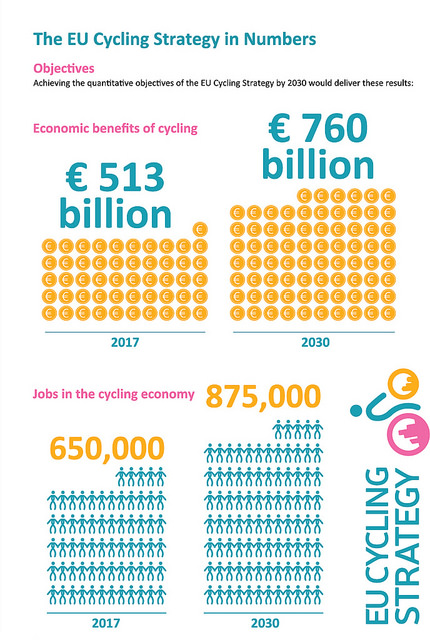
“We are not asking for special treatment, we want to be on the same level as every other mode of transport. Cycling already delivers 513 billion EUR of economic benefits in Europe every year and we can bring that number up to 760 billion EUR by 2030”, said Bernhard Ensink, Secretary General of the European Cyclists’ Federation.
"We need to build a stronger case for cycling – and the next year could be a great opportunity to do so. It will be the Year of Multimodality and a regulatory framework for cycling can be a strong component of it", said Violeta Bulc, EU Transport Commissioner, while receiving a suitcase with the EU Cycling Strategy recommendations on stage. "We should also work to ensure that cycling is even better reflected when it comes to funding, in particular for the next multiannual financial framework after 2020."
The EU Cycling Strategy contains recommendations directed at all levels of governance and addresses behaviour change, infrastructure, vehicle regulation, multimodality and intelligent transport systems. Taking into consideration the wider political framework, the EU Cycling Strategy focuses on how cycling can deliver jobs and growth through a financial and fiscal level playing field and a robust European bicycle industry. The objective is to put cycling on an equal status to other modes of transport in terms of policies and investments while showcasing the clear added value of the European level in the process.
What happens next?
Although the document is finished and in the Commission’s hands, official adoption is still very much open for discussion and influenced by political pressures. As a clear sign of support, 100 stakeholders co-signed an open letter that was sent today to the European Commission calling for the EU Cycling Strategy to be included in the Commission’s Work Programme 2018 or in subsequent initiatives. These partners also joined earlier calls from transport ministers, the European Parliament as well as the Committee of the Regions.
Read the full Press Release here.
Mobility as a Service (MaaS)
This session looked at how cycling services and systems, particularly Public Bike Share, can be incorporated into Mobility as a Service (MaaS).
Sampo Hietanen from MaaS Global Ltd. Introduced the work in Helsinki and how MaaS has actually been fully implemented (called WHIM) to include bike services. He said that the system works as long as it is better than owning a private car or simply being a trip planning service. It has to include a ‘package’ of choice, a subscription and offer a service. The system will also be opening up in the West Midlands in the UK soon. Helsinki seems to have the first fully functioning MaaS service in Europe and could be a model for other European cities to follow.
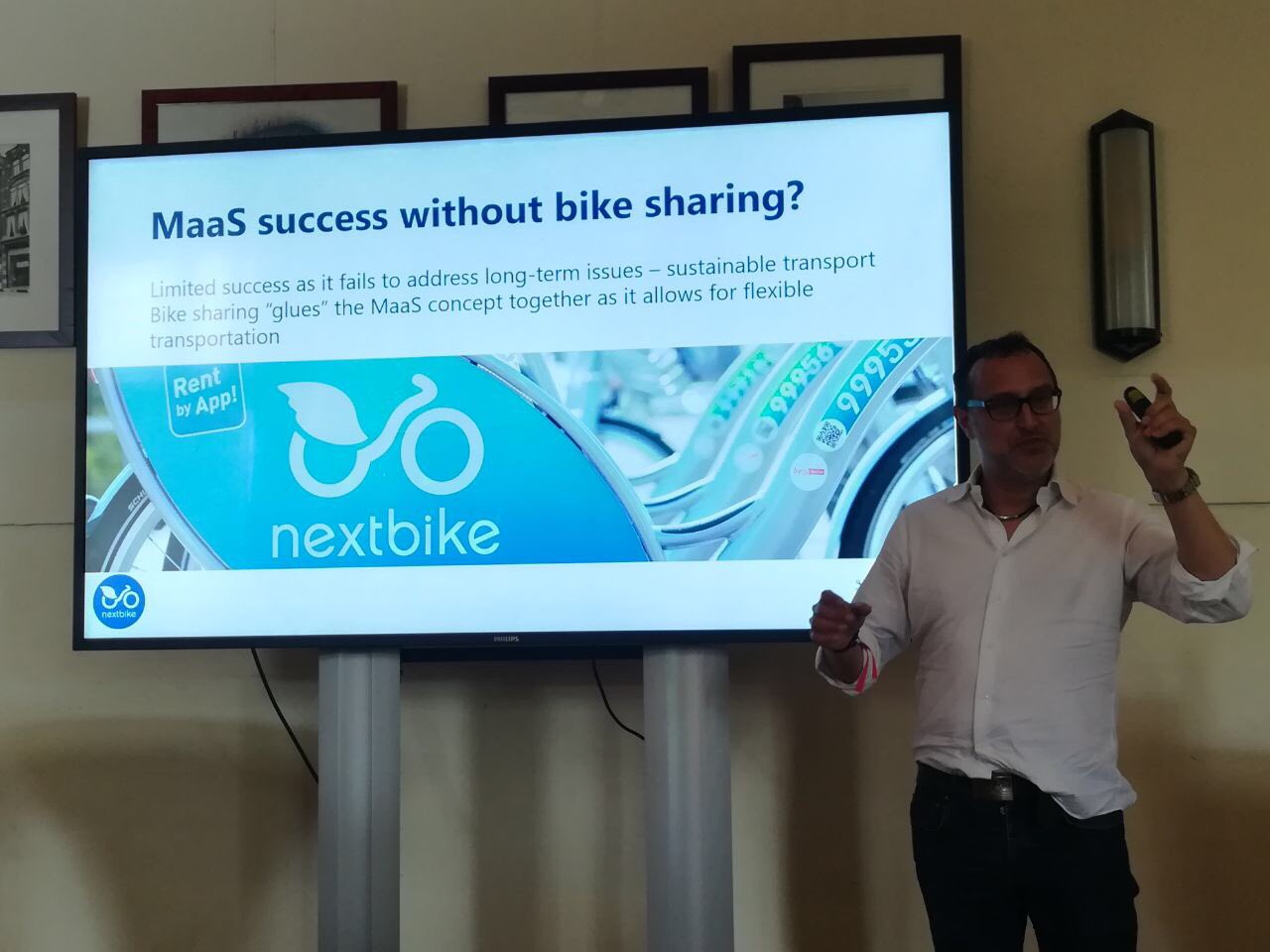
Dries Callebaut from Binamics, looked at the varius factors that could be involved in making cycling services more attractive for MaaS and how cycling can make MaaS more successful. There are lots of problems within cities that are caused by our current transport modes and many of the solutions proposed do not solve all the problems. For example, electric cars may solve some air pollution problems but they do not solve congestion or parking/space problems. But similarly bicycles don’t currently solve all transport users’ needs; moving heavy items; longer distances; weather issues, etc. MaaS does provide some solutions to these problems by combining the right mode of transport for the right job at hand. However if we are to have bicycles included within a MaaS system they should also be useful to those who want to use them. So bikes should be available that can carry heavier loads, or be electric for longer distances. Good business models will have to take into account including; having bikes specifically built for city use; having good security, particularly for expensive electric bikes; cargo bike services; and peer to peer services.
Julian Scriven from NextBike and who works with the Helsinki MaaS system made a useful distinction between an integrated transport system which may tack together various services onto one card, and a MaaS system that provides a full genuine service. For example it should provide genuine choice between services and systems, a payment package for all modes, real time updated information to make choices on quickest routes, and static journey planning. He again reiterated the point that MaaS cannot really be a success without the bicycle being in the mix, neither for the city nor for the user. It is necessary to put the bicycle on a level playing field with other modes and to provide good information for the choices and needs of the traveller to be respected.
Written by: Ceri Woolsgrove, Road Safety and Technical Policy Officer
The Best of Behavioural Change Campaigns
The Best of Behavioural Change Campaigns was presented by 5 inspirational pecha kucha style presentations.
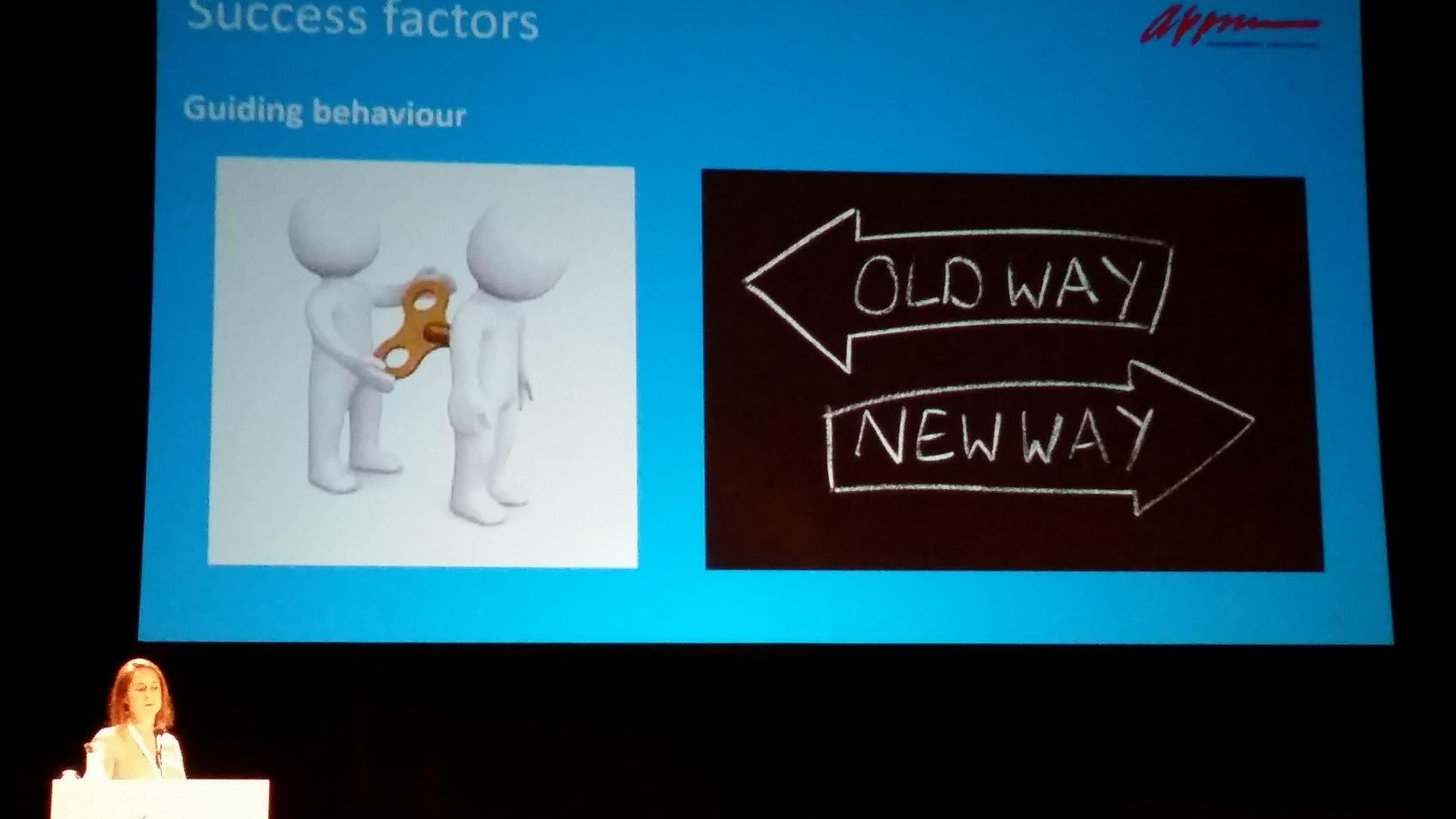
Paul van den Bosch from DTV Consultants talked about the Traffic Snake Game (www.trafficsnakegame.eu), a campaign which has been developed by Mobiel 21 in Flanders. The Traffic Snake Game is aimed at school children to convince their parents to choose a sustainable transport mode to get to school. The campaign runs for two weeks and has the kids daily measuring their transport modes. Recently a Traffic Snake Game 2.0 has been introduced with a digital whiteboard which reduces the costs for the schools involved making it possible for even a larger number of schools to join the campaign. The results of the campaign are quite impressive: 177. 587 pupils from 19 different countries convinced their parents to choose a sustainable travel mode to bring them to school.
Another inspiring example was presented by Anne Diepenbroek from APPM Management Consultants. The B-Riders campaign is a successful application developed specifically for commuters with similar common features as other cycling incentive applications such as GPS tracking, coaching and rewarding system. Anyone interested in creating its own app should remember that these applications are very effective but they are just a means in order to achieve a specific objective: more people cycling. Apps such as these should be simple and user friendly, gather useful cycling data and allow the building of a community of users.
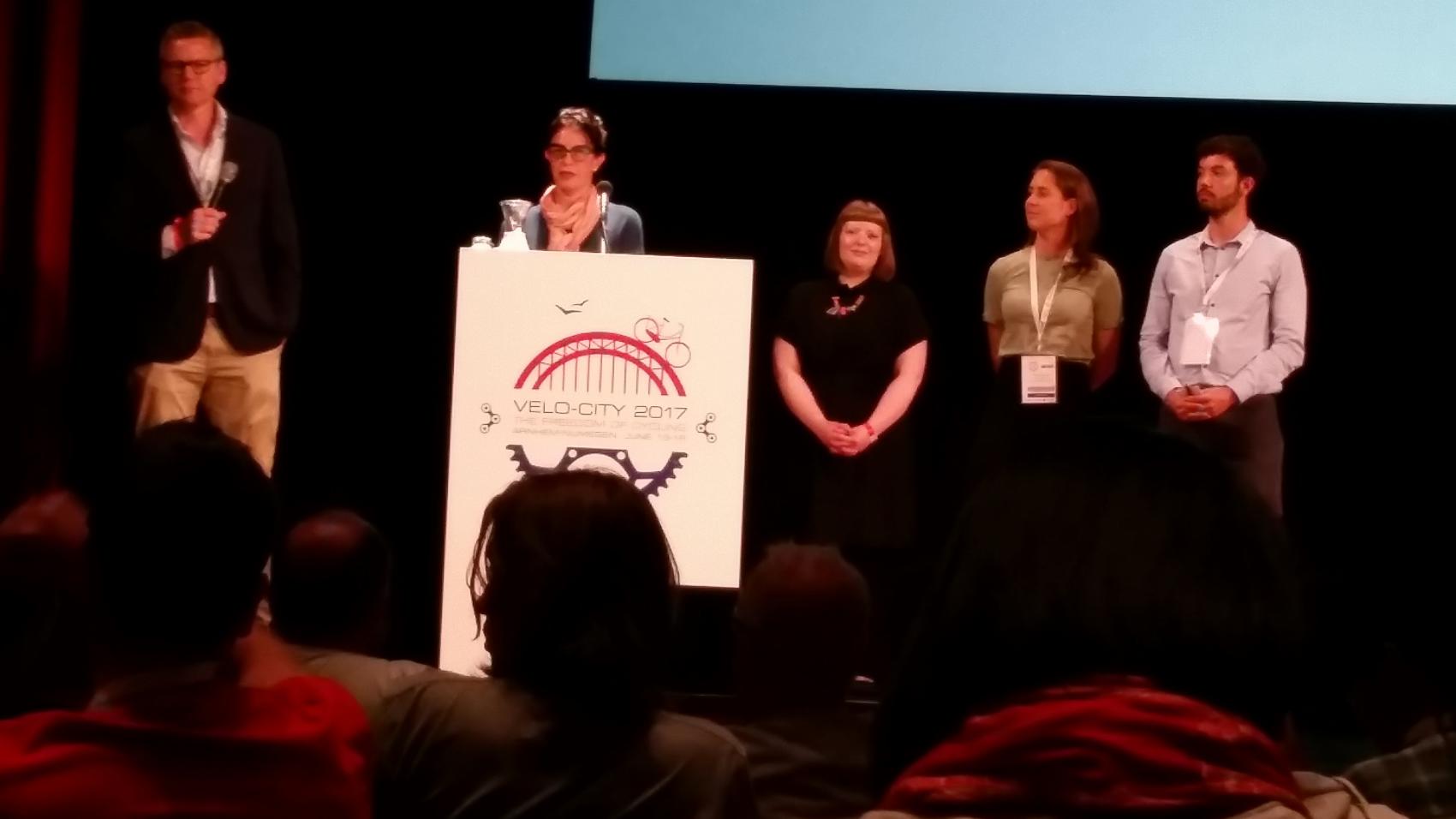 The third campaign was presented by Daniel Böhm from the Vienna Municipality Agency who received the inspiration for his campaign from life changing moment in his personal life. Daniel actually started cycling to work after his railway line was temporarily closed for maintenance and has cycled to work ever since. This experience provided the experience for a project in the city of Vienna to promote cycling as an alternative when a metro line in the city was closed for maintenance works. The City provided free bicycle parking and installed a bike station at the final stop. A cooperation with local retailers for a bike rental scheme was created and the Metro operator provided free communication in its media channels. The results speak for themselves: a 50% increase in bicycle usage during the 6 months campaign that cost only 60.000 EUR.
The third campaign was presented by Daniel Böhm from the Vienna Municipality Agency who received the inspiration for his campaign from life changing moment in his personal life. Daniel actually started cycling to work after his railway line was temporarily closed for maintenance and has cycled to work ever since. This experience provided the experience for a project in the city of Vienna to promote cycling as an alternative when a metro line in the city was closed for maintenance works. The City provided free bicycle parking and installed a bike station at the final stop. A cooperation with local retailers for a bike rental scheme was created and the Metro operator provided free communication in its media channels. The results speak for themselves: a 50% increase in bicycle usage during the 6 months campaign that cost only 60.000 EUR.
A similar campaign was presented by Caroline Hammond from Cycling Scotland. During infrastructure works in the station of Glasgow Queen Street, a campaign for active travel as an alternative during the railroad disruption was launched. One of the main learning points from this campaign was the fact that the running period of three months was definitely not enough.
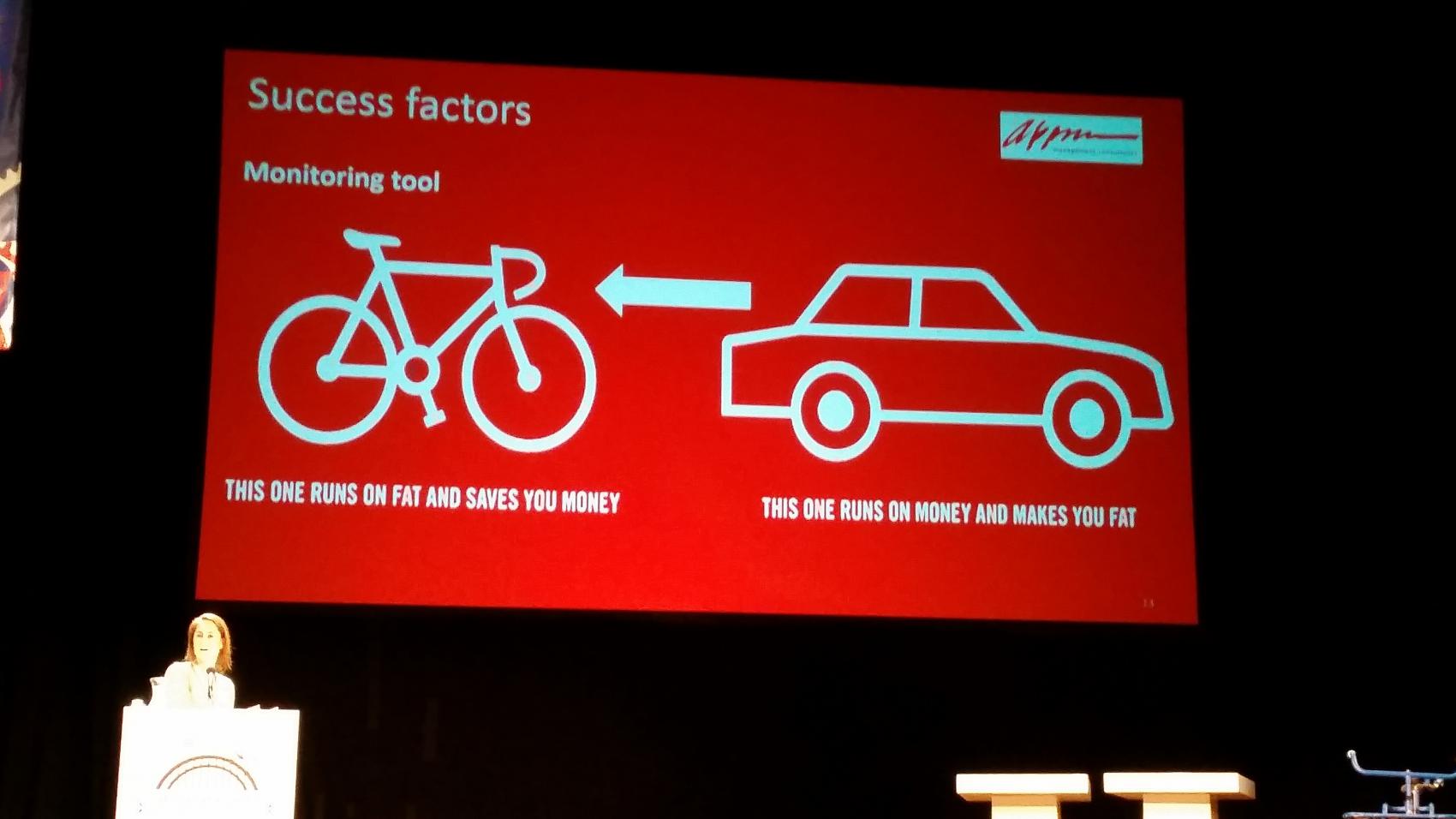
Finally, Eveline Trevisan from Belo Horizonte City Hall, presented one of the first bike lanes ever to be constructed in the city of Belo Horizonte. After its constructions the City Hall received a lot of complaints about the quality of the bike lane. Fortunately, in the end this lead to the Pedala BH Campaign: an open, consultative and leaderless working group, formed by civil society, associations and public power. It discusses the use of the bicycle in Belo Horizonte. “The key is to listen, learn and work together, concluded Eveline Trevisan, which is something all these successful behavioural change campaigns have in common.
Written by: Carolien Ruebens, Senior Project Officer
Combining everyday cycling and leisure: complimentary or challenging?
Nijmegen has a population of 174000 and is “still trying to improve policy to deliver what cyclists want: good connections, safe routes, not breathing lots of air pollution” said Harriët Tiemens, Nijmegen city alderman responsible for Sustainability, Green & Water and Mobility.
Where the famous Dutch solution of cycle streets, are not possible, they focus on reducing speeds from 50 to 30kph for large sections of the city. This is needed to provide safe space for pedestrians and cyclists, “Because they know the best ways to get around” said alderman Tiemens. “30k is safe enough for children.” she added that speed pedelecs are a challenge that is still being debated in the Netherlands.
There were 2000 people on Thursday’s Velo-city cycle parade which went through Nijmegen’s Goffart Park. The alderman explained that the Park was the scene of a tough political problem to solve due to conflicting user demands. The solution was found by consulting the users: pedestrians primarily wanted to use the park outside the rush hours that the cyclists wanted. The result was the beautiful infrastructure enjoyed by the masses last night.
Marc Andre Gadoury, city councillor From Montreal, said that wherever they find conflicts, they try to enlarge the cycle path. There are speed limits for bikes in parks and other places where there are many other road users. After the session, Mr Gadoury added “We try to share the space because it’s better to do so. Living together is the Montreal mayor’s moto, for all things, and certainly for transport.”
In Budapest, the EuroVelo 6 and the Rakos-Stream greenway were the scene for several different types of challenges explained Akos Bereczky, from the BKK centre for Budapest Transport. The increasing popularity of these routes on the last several years has raised the profile of the conflicts. These are common in areas where cyclists must share space with pedestrians. One example cited was caused by the recent re-routing of a cycle path to cross over tram tracks. Until political decision changed it a few years ago, it was shared space. But many cyclists chose not to cross the tram tracks, and continued cycling on the pedestrian infrastructure.
Ed Lancaster, ECF Policy Officer for EuroVelo, and moderator of this session, noted that Akos Bereczky and many others have said that Velo-city has inspired people with ideas that they are going to take back home.
Written by: Dr Randy Rzewnicki, Health Policy Officer
Mayors' Session
The European Commissioner of Transport and over twenty Mayors from across the world embraced the freedom of cycling, recognizing that humans should be at the center of urban planning. In an informal setting where they could be open with each other, the mayors agreed that although there are many challenges, cycling is vital for the future of climate and environment. Everyone felt inspired by the Dutch freedom of cycling and discussed ways to make cycling part of their own DNA by adjusting its principles into their own culture. As a sign of commitment, they even took their bikes to work!
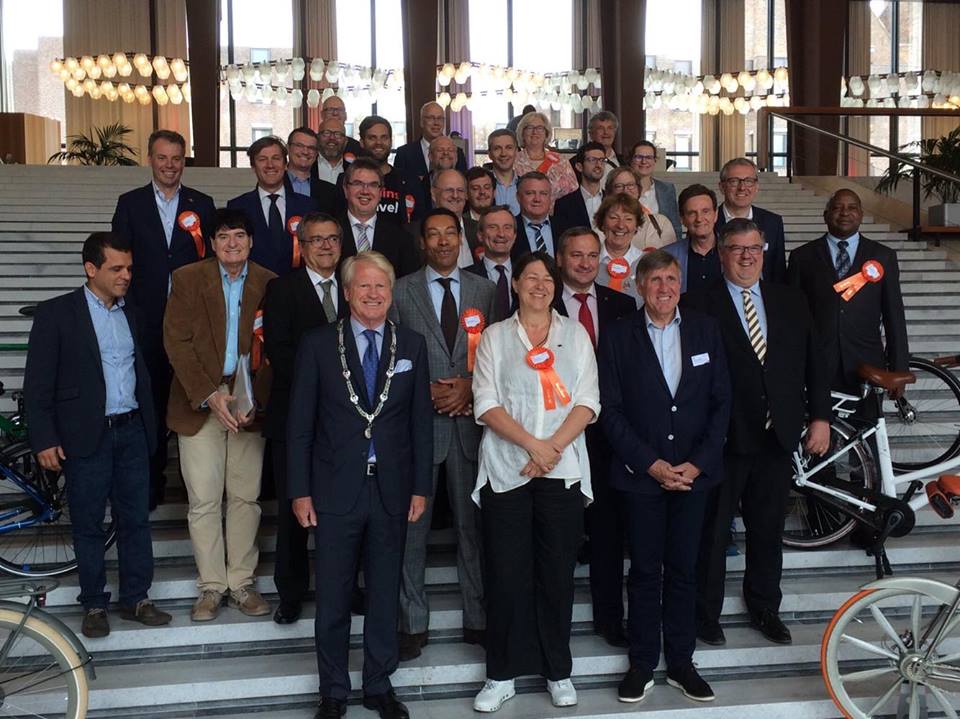
Officials present
- European Commissioner for Transport, Violeta Bulc
- ITF Secretary General, Jose Viegas
- Luxembourg Minister for Transport, Francois Bausch
- Regional Minister of the Province of Gelderland, Conny Bieze
- ECF Secretary General Bernhard Ensink
- Mayor of Arnhem, Boele Staal
- Mayor of Nijmegen, Hubert Bruls
- Deputy Mayor of Amsterdam, Pieter Litjens
- Vice Mayor of Paris (France), Christophe Najdovski
- Vice Mayor of Leuven (Belgium), Mohamed Ridouani
- Mayor of Deinze (Belgium) Jan Vermeulen
- Mayor of Mannheim (Germany), Peter Kurz
- Mayor of Karisruhe (Germany), Michael Obert
- Mayor of Dusselforf (Germany), Thomas Geisel
- Mayor of Pskov (Russia), Ivan Tsetsersky
- Mayor of Kampala (Uganda), Emmanuel Serunjoji
- Deputy Mayor Ljubljana (Slovenia), Prof. Janez Kozelj
- Deputy Mayor of Gdansk (Poland) Mrs Aleksandra Dulkiewicz
- Mayor of Dublin (Ireland) Brendan Carr
- Vice President of Nantes Metropole (France) Jazques Garreau
- Vice Mayor of Strassbourg (France) Jean-Baptiste Gernet
- Mayor of Rio de Janeiro (Brazil) Marcelo Crivella
- Deputy Mayor of Curitiba (Brazil) Jorge Brand
- Secretary of Transport & Mobility of Sao Paulo (Brazil) Sergio Avelleda
Closing ceremony
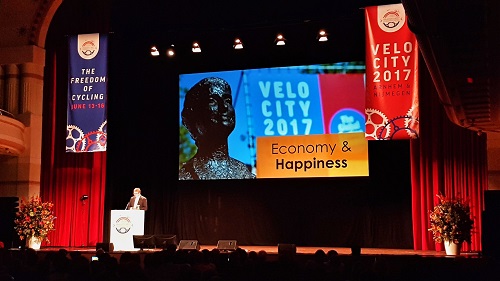
A wrap-up of the ceremony in the words of ECF Secretary General, Dr Berhard Ensink: “I’ve heard from many people that they’d learned and been inspired during this Velo-city,”
We learnt that ‘going Dutch’ means 1 king and millions of queens and kings on the road, that transportation systems are not gender neutral, to focus more on people than on vehicles, and that we all want happy people. We learned from each other it is possible to change cities into better places, and that this ultimately needs good governance. Seven points, as the word Bicycle has seven letters, the vehicle that was invented 200 years ago.
Regions:
Network/Project Involved:
Topics:
Contact the author
Recent news!
Upcoming events
Contact Us
Avenue des Arts, 7-8
Postal address: Rue de la Charité, 22
1210 Brussels, Belgium









